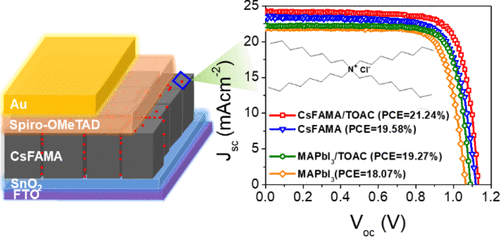当前位置:
X-MOL 学术
›
ACS Appl. Mater. Interfaces
›
论文详情
Our official English website, www.x-mol.net, welcomes your
feedback! (Note: you will need to create a separate account there.)
Universal Surface Passivation of Organic–Inorganic Halide Perovskite Films by Tetraoctylammonium Chloride for High-Performance and Stable Perovskite Solar Cells
ACS Applied Materials & Interfaces ( IF 8.3 ) Pub Date : 2022-06-09 , DOI: 10.1021/acsami.2c09201 Seid Yimer Abate 1 , Qiqi Zhang 1 , Yifang Qi 1 , Jawnaye Nash 1 , Kristine Gollinger 1 , Xianchun Zhu 1 , Fengxiang Han 1 , Nihar Pradhan 1 , Qilin Dai 1
ACS Applied Materials & Interfaces ( IF 8.3 ) Pub Date : 2022-06-09 , DOI: 10.1021/acsami.2c09201 Seid Yimer Abate 1 , Qiqi Zhang 1 , Yifang Qi 1 , Jawnaye Nash 1 , Kristine Gollinger 1 , Xianchun Zhu 1 , Fengxiang Han 1 , Nihar Pradhan 1 , Qilin Dai 1
Affiliation

|
The power conversion efficiency (PCE) of perovskite solar cells has been showing rapid improvement in the last decade. However, still, there is an unarguable performance deficit compared with the Schockley–Queisser (SQ) limit. One of the major causes for such performance discrepancy is surface and grain boundary defects. They are a source of nonradiative recombination in the devices that not only causes performance loss but also instability of the solar cells. In this study, we employed a direct postsurface passivation strategy at mild temperatures to modify perovskite layer defects using tetraoctylammonium chloride (TOAC). The passivated perovskite layers have demonstrated extraordinary improvement in photoluminescence and charge carrier lifetimes compared to their control counterparts in both Cs0.05(FAPbI3)0.83(MAPbBr3)0.17 and MAPbI3-type perovskite layers. The investigation on electron-only and hole-only devices after TOAC treatment revealed suppressed electron and hole trap density of states. The electrochemical study demonstrated that TOAC treatment improved the charge recombination resistance of the perovskite layers and reduced the charge accumulation on the surface of perovskite films. As a result, perovskite solar cells prepared by TOAC treatment showed a champion PCE of 21.24% for the Cs0.05(FAPbI3)0.83(MAPbBr3)0.17-based device compared to 19.58% without passivation. Likewise, the PCE of MAPbI3 improved from 18.09 to 19.27% with TOAC treatment. The long-term stability of TOAC-passivated perovskite Cs0.05(FAPbI3)0.83(MAPbBr3)0.17 devices has retained over 97% of its initial performance after 720 h in air.
中文翻译:

四辛基氯化铵对有机-无机卤化物钙钛矿薄膜的通用表面钝化用于高性能和稳定的钙钛矿太阳能电池
钙钛矿太阳能电池的功率转换效率 (PCE) 在过去十年中一直在迅速提高。然而,与 Schockley-Queisser (SQ) 限制相比,仍然存在无可争辩的性能缺陷。这种性能差异的主要原因之一是表面和晶界缺陷。它们是器件中非辐射复合的来源,不仅会导致性能损失,还会导致太阳能电池的不稳定。在这项研究中,我们在温和的温度下采用直接后表面钝化策略来使用四辛基氯化铵 (TOAC) 修改钙钛矿层缺陷。与 Cs 0.05(FAPbI3 ) 0.83 (MAPbBr 3 ) 0.17和MAPbI 3型钙钛矿层。在 TOAC 处理后对纯电子和纯空穴器件的研究表明,电子和空穴陷阱的状态密度受到抑制。电化学研究表明,TOAC处理提高了钙钛矿层的电荷复合阻力,减少了钙钛矿薄膜表面的电荷积累。结果,通过 TOAC 处理制备的钙钛矿太阳能电池显示出 Cs 0.05 (FAPbI 3 ) 0.83 (MAPbBr 3 ) 0.17的冠军 PCE 为 21.24%基器件相比没有钝化的器件为 19.58%。同样,MAPbI 3的 PCE 在TOAC 处理下从 18.09% 提高到 19.27%。TOAC 钝化的钙钛矿 Cs 0.05 (FAPbI 3 ) 0.83 (MAPbBr 3 ) 0.17器件的长期稳定性在空气中 720 小时后仍保持其初始性能的 97% 以上。
更新日期:2022-06-09
中文翻译:

四辛基氯化铵对有机-无机卤化物钙钛矿薄膜的通用表面钝化用于高性能和稳定的钙钛矿太阳能电池
钙钛矿太阳能电池的功率转换效率 (PCE) 在过去十年中一直在迅速提高。然而,与 Schockley-Queisser (SQ) 限制相比,仍然存在无可争辩的性能缺陷。这种性能差异的主要原因之一是表面和晶界缺陷。它们是器件中非辐射复合的来源,不仅会导致性能损失,还会导致太阳能电池的不稳定。在这项研究中,我们在温和的温度下采用直接后表面钝化策略来使用四辛基氯化铵 (TOAC) 修改钙钛矿层缺陷。与 Cs 0.05(FAPbI3 ) 0.83 (MAPbBr 3 ) 0.17和MAPbI 3型钙钛矿层。在 TOAC 处理后对纯电子和纯空穴器件的研究表明,电子和空穴陷阱的状态密度受到抑制。电化学研究表明,TOAC处理提高了钙钛矿层的电荷复合阻力,减少了钙钛矿薄膜表面的电荷积累。结果,通过 TOAC 处理制备的钙钛矿太阳能电池显示出 Cs 0.05 (FAPbI 3 ) 0.83 (MAPbBr 3 ) 0.17的冠军 PCE 为 21.24%基器件相比没有钝化的器件为 19.58%。同样,MAPbI 3的 PCE 在TOAC 处理下从 18.09% 提高到 19.27%。TOAC 钝化的钙钛矿 Cs 0.05 (FAPbI 3 ) 0.83 (MAPbBr 3 ) 0.17器件的长期稳定性在空气中 720 小时后仍保持其初始性能的 97% 以上。


















































 京公网安备 11010802027423号
京公网安备 11010802027423号